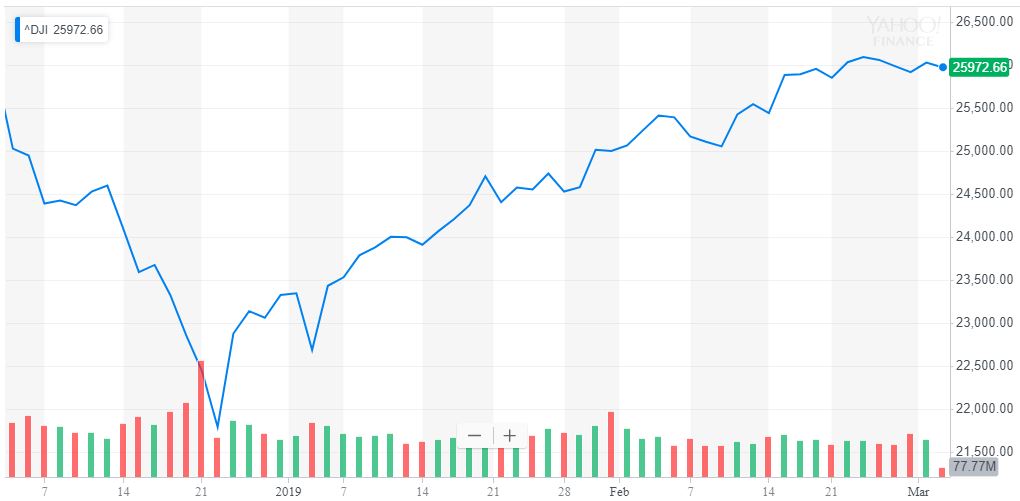Why the Dow Jones Sell-Off Will Be Erased by a Swift Recovery

The Dow took an absolute beating on Monday, but China may hold the key to that rescues the US stock market. | Source: Shutterstock
The Dow Jones Industrial Average cratered on Monday, shedding more than 350 points by midday after the index snapped a streak of nine consecutive weekly gains. However, fundamental factors still indicate that the index could be primed for a massive rally.
SSE Composite Breaks Through Important Technical Barrier
Also on Monday, the Chinese stock market achieved a 9-month high after the SSE Composite surged by 3.2 percent on the day. Analysts foresee the strength of the Chinese market being reflected onto the Dow Jones in the days to come as both are driven by the same fundamental factor: the trade deal.
The SSE Composite, which represents the performance of all stocks that are traded at the Shanghai Stock Exchange, broke out of 3,000 points for the first time since May 2019.
The surge in Chinese stocks followed reports suggesting that the U.S. and China are at the final phase of the trade talks.
Trade Deal Very Close to Being Complete, How Will the Dow Jones React?
In the upcoming weeks, Chinese and the U.S. negotiators are expected to finalize the core components of a full trade agreement.
While both sides still remain cautious in ensuring the deal is beneficial to both countries, China is expected to bump up imports of U.S. goods while the U.S. is set to remove most sanctions on Chinese goods.
Tariffs on key products like cars, chemical, livestock, and a wide range of other products are likely to be dropped.
Hurdles in the trade talks still exist. Namely, China is expected to remain firm on its stance on the structural reforms and industrial policy changes requested by the U.S., which analysts say could remain as the final roadblock in the trade discussions.
However, with the U.S. President Donald Trump unable to reach a deal at the Vietnam summit and the economy of China still facing economic slowdown due to the struggle of the domestic market, both countries are said to be urgently moving toward a deal.
“His failure to get a deal in Vietnam increases the pressure on him to get a deal with the Chinese,” Fred Bergsten, founder of the Institute for International Economics, told the Wall Street Journal.
As said by Yang Guangpu, an associate research fellow at a China’s State Council think tank called the Development Research Center, China is highly unlikely to speed up the process of carrying out structural reforms as a part of the trade deal.
But, China is already in the process of doing so, and the progress with a roadmap may be sufficient to push the trade deal forward.
“China is carrying out [state-company] reforms in an orderly fashion, and won’t change the pace because of the trade tensions with the U.S.,” Guangpu said .
With the trade deal close to being signed by President Donald Trump and President Xi Jinping, possibly by March 27, and the Chinese stock market responding to it, the Dow Jones is projected to demonstrate strong momentum in the weeks to come.

Earlier this year, when the outcome of the trade talks was still an uncertainty, Standard Life Aberdeen co-CEO Martin Gilbert said that the geopolitical risks created by the U.S.-China trade war had put the U.S. market in a worse position than in 2018.
“(There’s) a lot of geopolitical risk between the U.S. and China — certainly we are in a worse place than we were a year ago,” Gilbert said .
Many industry executives believe the prospect of the trade deal is mostly priced in but a full agreement is not, and if a comprehensive deal is achieved by the end of March, a rapid Dow Jones rally is likely to occur.
Momentum is Rising in U.S. Stock Market
Until Monday, the Dow Jones had kept the 26,000-point level relatively well in recent weeks, and while the market took a turn for the worse today, the overall stability of the U.S. market could appeal investors in the near-term who were reluctant towards re-entering the stock market after a volatile several months in late 2018.